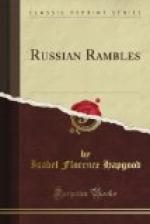When the present Admiralty was built, a broad and shady boulevard was organized on the site of the old glacis and covered way, and later still, when the break in the quay was filled in, and the shipbuilding transferred to the New Admiralty a little farther down the river, the boulevard was enlarged into the New Alexander Garden, one of the finest squares in Europe. It soon became the fashionable promenade, and the centre of popular life as well, by virtue of the merry-makings which took place. Here, during the Carnival of 1836, the temporary cheap theatre of boards was burned, at the cost of one hundred and twenty-six lives and many injured persons, which resulted in these dangerous balagani and other holiday amusements being removed to the spacious parade-ground known as the Empress’s Meadow.
If we pass round the Admiralty to the Neva, we shall find its frozen surface teeming with life. Sledge roads have been laid out on it, marked with evergreen bushes, over which a yamtschik will drive us with his troika fleet as the wind, to Kronstadt, twenty miles away. Plank walks, fringed with street lanterns, have been prepared for pedestrians. Broad ice paths have been cleared, whereon the winter ferry-boats ply, —green garden-chairs, holding one or more persons, furnished with warm lap-robes, and propelled by stout muzhiks on skates, who will transport us from shore to shore for the absurdly small sum of less than a cent apiece, though a ride with the reindeer (now a strange sight in the capital), at the Laplanders’ encampment, costs much more.
It is hard to tear ourselves from the charms of the river, with its fishing, ice-cutting, and many other interesting sights always in progress. But of all the scenes, that which we may witness on Epiphany Day—the “Jordan,” or Blessing of the Waters, in commemoration of Christ’s baptism in the Jordan—is the most curious and typically Russian.
After mass, celebrated by the Metropolitan, in the cathedral of the Winter Palace, whose enormous reddish-ochre mass we perceive rising above the frost-jeweled trees of the Alexander Garden, to our right as we stand at the head of the Nevsky Prospekt, the Emperor, his heir, his brothers, uncles, and other great personages emerge in procession upon the quay. Opposite the Jordan door of the palace a scarlet, gold, and blue pavilion, also called the “Jordan,” has been erected over the ice. Thither the procession moves, headed by the Metropolitan and the richly vestured clergy, their mitres gleaming with gems, bearing crosses and church banners, and the imperial choir, clad in crimson and gold, chanting as they go. The Empress and her ladies, clad in full Court costume at midday, look on from the palace windows. After brief prayers in the pavilion, all standing with bared heads, the Metropolitan dips the great gold cross in the rushing waters of the Neva, through a hole prepared in the thick, opalescent, green ice, and the guns on the opposite shore thunder out a salute. The pontoon Palace Bridge, the quays on both sides of the river, all the streets and squares for a long distance round about, are densely thronged; and, as the guns announce the consecration, every head is bared, every right hand in the mass, thousands strong, is raised to execute repeated signs of the cross on brow and breast.




